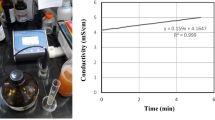Abstract
Improvement and stabilization of soils are widely used as an alternative to substitute the lacking of suitable material on site. Soils may be stabilized to increase strength and durability or to prevent erosion and dust generation. The use of nontraditional chemical stabilizers in soil improvement is growing daily. A new stabilizing agent was developed to improve the mechanical performance and applicability of clayey soils. In this study a laboratory experiment is conducted to evaluate the effects of plasticity index and waterborne polymer on the Unconfined Compression Strength (UCS) of clayey soils. The laboratory tests include sieve analysis, hydrometer, Atterberg limits, modified compaction and unconfined compression tests. Three clayey soils with different plasticity indexes were mixed with various amounts of polymer (2, 3, 4 and 5%) and compacted at the optimum water content and maximum dry density. The unstabilized and stabilized samples were subjected to unconfined compression tests to determine their strength at different curing times. The results of the tests indicated that the waterborne polymer significantly improved the strength behavior of unsaturated clayey soils. Also, an increase in plasticity index causes a reduction in unconfined compression strength.
Similar content being viewed by others
References
Ajayi-Majebi, W. A., Grissom, L. S., and Jones, E. E. (1995). “Epoxyresin-based chemical stabilization of a fine, poorly graded soil system.” Transportation Research Record, TRB, National Research Council, Washington, D.C.
Al-Khanbashi, A. and Abdalla S. H. W. (2006). “Evaluation of three waterborne polymers as stabilizer for sandy soil.” Geotechnical and Geological Engineering, Vol. 24, No. 6, pp. 1603–1625.
Al-Khanbashi, A. and El-Gamal, M. (2003). “Modifition of sandy soil using waterborne polymer.” Journal of Applied Polymer Science, Vol. 88, Issue 10, pp. 2484–2491.
Alexander, M. L., Smith, R. E., and Sherman, G. B. (1972). Relative stabilizing effect of various limes on clayey soils, Bulletin 381, Highway Research Board.
Amu, O. O., Adeyeri, J. B., Haastrup, A. O., and Eboru, A. A. (2008). “Effects of palm kernel shells in lateritic soil for asphalt stabilization.” Research Journal of Environmental Sciences, Vol. 2, No. 2, pp. 132–138.
ASTM D 1557 (2002). Standard test methods for laboratory compaction characteristics of soil using modified effort, American Society for Testing and Materials, Philadelphia.
ASTM D 2166 (2006). Standard test method for unconfined compressive strength of cohesive soils, American Society for Testing and Materials, Philadelphia.
ASTM D 442-63 (2007). Standard test method for particle-size analysis of soils, American Society for Testing and Materials, Philadelphia.
Daniels, J. L. and Inyang, H. L. (2004). “Contaminant barrier material textural response to interaction with aqueous polymers.” Journal of Material and Civil Engineering, Vol. 16, No. 3, pp. 265–275.
Daniels, J. L., Inyang, H. I., and Iskandar, I. K. (2003). “Durability of Boston blue clay in waste containment applications.” Journal of Material and Civil Engineering, Vol. 15, No. 2, pp. 144–155.
Eades, J. L. and Grim, R. E. (1960). Reaction of hydrated lime with pure clay minerals in soil stabilization, Bulletin 262, Highway Research Board. Washington, D.C.
Fang H. Y. (1991). Foundation engineering handbook, Chapman & Hall, New York, NY10119.
Ferguson, G. (1989). “Stabilizing with fly ash. Replacement for portland cement or lime.” Transportation Research Record 1219, TRB, National Research Council, Washington, D.C., pp. 68–81.
Ferguson, G. and Levorson, S. M. (1999). Soil and pavement base stabilization with self-cementing coal fly ash, American Coal Ash Association, Alexandria, Virginia.
Gopal, R. J., Singh, S., and Das, G. (1983). “Chemical stabilization of sand comparative studies on urea-formaldehyde resins as dune sand stabilizer and effect of compaction on strength (Part IV).” Indian Society of Desert Technology, Vol. 8, No. 2, pp. 13–19.
Green, V. S., Stott, D. E., and Norton, L. D., and Graveel, J. G. (2000). “Polyacrylamide molecular weight and charge effects on infiltration under simulated rainfall.” Soil Sci. Am. J., Vol. 64, pp. 1786–1791.
Kestler, M. A. (2009). Stabilization selection guide for aggregate and native-surfaced low-volume roads, Civil Engineer, Forest Service, San Dimas Technology & Development Center.
Little, D. N., Males, E. H., Prusinski, J. R., and Stewart, B. (2000). Cementations stabilization. Transportation in the new millennium: Perspectives from TRB standing committees, Committee A2J01, Committee on Cementations Stabilization, National Research Council. Washington, D.C.
Moustafa, A. B., Bazara, A. R., and Nour El-Din, A. R. (2003). “Soil stabilization by polymeric materials.” Angenandte MaKromoleKular Chemie., Vol. 97, No. 1, pp. 1–12.
Naeini, S. A. and Mahdavi, A. (2009). Effect of polymer on shear strength of silty sand, Master’s. Thesis, Civil Engineering Department, Imam Khomeini International University.
Oldham, J. C., Eaves, R. C., and White, D. W. (1997). “Materials evaluated as potential soil stabilizers.” U.S. Army Engineer Waterways Experiment Station, pp. 77–15.
Palmer, J. T., Edgar, T. V., and Boresi, A. P. (1995). Strength and density modification of unpaved road soils due to chemical additives, Master’s Thesis, Department of Civil and Architectural Engineering, University of Wyoming.
Perloff, W. H. (1976). Soil mechanics, principal and applications, John Wiley & Sons. New York.
Prusinski, J. R. and Bhattacharya, S. (1999). “Effectiveness of portland cement and lime in stabilizing clay soils.” Transportation Research Record 1652, TRB, National Research Council, Washington, D.C., pp. 215–227.
Santoni, R. L., Tingle, J. S., and Webster, S. L. (2003). “Stabilization of silty sand with non-traditional additives.” Transportation Research Record 1787, TRB, National Research Council, Washington, D.C., pp. 33–41.
Author information
Authors and Affiliations
Corresponding author
Rights and permissions
About this article
Cite this article
Naeini, S.A., Naderinia, B. & Izadi, E. Unconfined compressive strength of clayey soils stabilized with waterborne polymer. KSCE J Civ Eng 16, 943–949 (2012). https://doi.org/10.1007/s12205-012-1388-9
Received:
Revised:
Accepted:
Published:
Issue Date:
DOI: https://doi.org/10.1007/s12205-012-1388-9




